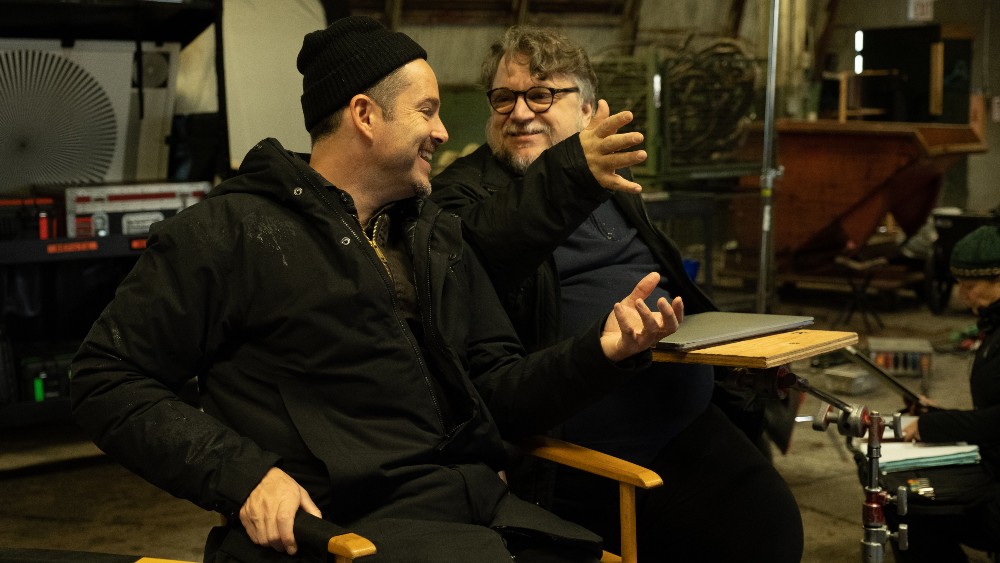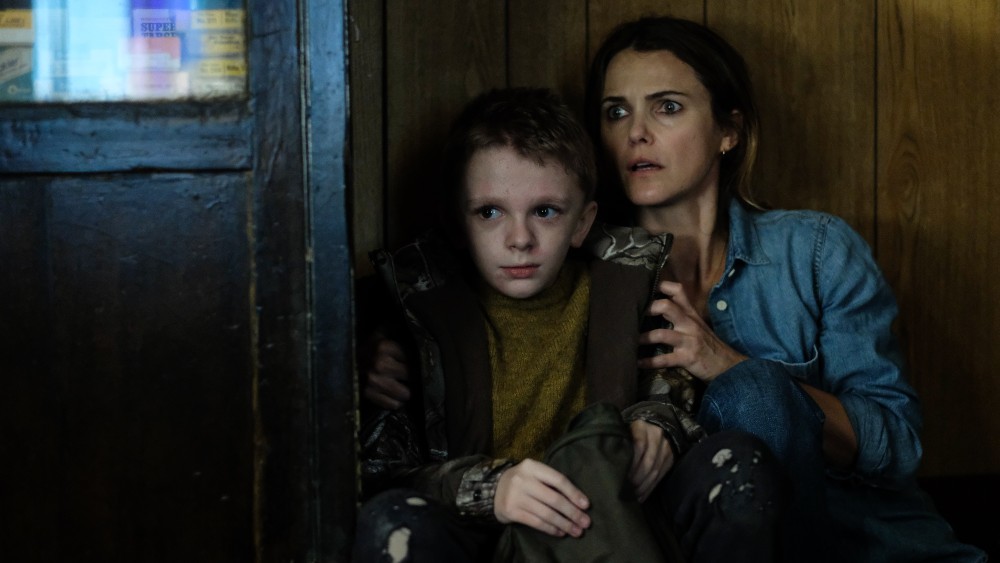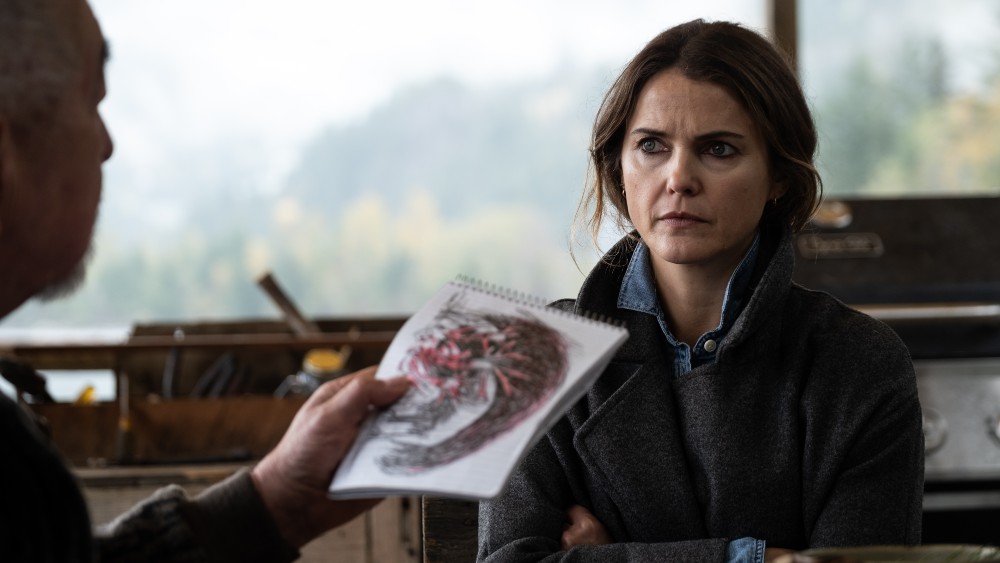If you know Director Scott Cooper‘s work from any of his earlier films — whether it’s directing Jeff Bridges to an Oscar for the drama Crazy Heart; making the Whitey Bulger film Black Mass with Johnny Depp; or the Appalachian crime-thriller Out of the Furnace and Western, Hostiles, with Christian Bale — you might be surprised to learn that he’s made a horror film.
In fact, he has teamed with Producers Guillermo del Toro and David Goyer (who made the highly underrated horror-superhero film, Blade II, almost two decades past) to make Antlers, based on the short story, “A Quiet Boy” by Nick Antosca. While Antlers has all of the chills and scares and gore any horror enthusiast could ask for, it’s also a human story, about a motherless family with a young 12-year-old boy named Lucas (Jeremy T. Thomas) has to contend with a father (Scott Haze) and younger brother (Sawyer Jones), who have gotten very sick to the point where Lucas needs to lock them up in the attic. It’s also a story about Lucas’ teacher Julia (Keri Russell) and her sheriff brother Paul (Jesse Plemons), who are contending with their own family issues as bodies start turning up in their small Oregon mining town.
As with many of Cooper’s other films, Antlers mixes genre with spirituality, particularly the Indigenous lore and myths that play a major role in the terror being experienced by the film’s characters. If you’ve read Below the Line‘s review of Antlers, you’ll see that the film shows off some amazing craftsmanship from all of the people Cooper worked with on the film.
Below the Line got on Zoom earlier this week to talk with Cooper about what was involved with making Antlers.
Below the Line: Hey, Scott, I’m with Below the Line now, which is a little different, because we’ll talk about production and editing and visual FX and other such things.
Scott Cooper: Great, man. I love my below-the-line crew.
BTL: Let’s start at the beginning. I know this was based on a short story, so was it being developed by someone else who came to you to direct?
Cooper: It was. Guillermo del Toro approached me, and he said, “Scott, your last three films have been horror films, and nobody knows it. Would you consider directing a horror film?” I said, “Yes. I love the genre. Many of my favorite films are horror films. When I was a kid, my brother would take me to see things I was too young to see, which still have an effect on me. And I loved Nick Antosca’s short story, “A Quiet Boy,” and there was an existing screenplay, but Guillermo also is well aware that I write all the films that I direct. I then wanted to discover and talk about some of the themes that we’re dealing with today, kind of hold up a dark mirror to our fears and anxieties that we face as Americans, and there are a lot of them.
BTL: When you read the short story, was it very obvious that this would have to be a horror movie?
Cooper: That was certainly their intent. I mean, Guillermo, of course, is a horror Maestro. My sensibilities as a filmmaker and Guillermo’s are vastly different. It’s a miracle that any of this film works at all, but I loved the challenge, because I think as a filmmaker, the great danger is in doing safe work. I always want to be pushed into an uncomfortable space, which is why I’ve made a musical drama and a gangster film and a Western and now horror. I think making the same film over and over, it’s dangerous and holds no interest for me.

BTL: I know Guillermo puts as much of himself into a project when he’s producing as he does when he’s directing, not that he would get in your way as a director. He just really brings his enthusiasm and love of horror and film to his work, including doing some commercials for Antlers. I mean, he’s more than just a name in the credits.
Cooper: He’s very generous as a producer, both with his time and his ideas, and I’ve grown very close to him. He’s the fourth director to produce my films. Robert Duvall produced Crazy Heart. Ridley and Tony Scott and Leonardo DiCaprio produced Out of the Furnace, and now Guillermo. They really understand what a director faces at all times, all the challenges and pitfalls, so it’s nice to have that.
BTL: You always seem to be able to find these amazing locations, like the one in Out of the Furnace, which ended up drawing inspiration from its location. I feel this one was the same. How did you figure out where you want to shoot this?
Cooper: Very carefully. I didn’t want to go back to Appalachia, the American Rust Belt. I’ve shot Crazy Heart in the American Southwest. Hostiles, I started New Mexico and made my way up the Continental Divide towards Montana. Shot Black Mass, the Whitey Bolger story, in the mean streets of Boston. But I hadn’t yet shot in the Pacific Northwest, and I’m interested in coastal Oregon. It’s a place that might feel left behind, and there’s a certain gloomy mystery that I find incredibly enchanting and beautiful there. And even though I shot it North of Vancouver, it still evokes that same region. I try always, for my landscape to serve as an important character, as the lead of the film, so I’m glad that you feel that atmosphere.
BTL: It looks amazing, and it just sets up the environment, so that you immediately feel the downtroddenness of the people there. Between the location and what your production designer did in setting up the shops and streets, really did a great job.
Cooper: Look, there’s a spiritual devastation that’s kind of coursing through these forgotten small towns in America, and I try not to forget them. These small towns and the people that inhabit them have been front and center in my films, and I think it’s important we don’t forget them. It one time served as the industrial backbone to this nation, but once a factory or a mine closes, the whole fabric of that town changes, so I’m happy that you noticed that. Thank you.
BTL: I also want to talk about Jeremy and Sawyer. You’ve had kids in your movies before, but maybe not to this degree where one is literally the lead. How do you go about finding them? Do you have a casting director you’ve worked with on all your movies?
Cooper: Yeah, I mean, very carefully. I think we saw about 900 boys, just for the role of Lucas around the English-speaking world. Most of the kids have agents, they have acting coaches, or parents that coach them, and they come already predetermined, having made their choices. They can cry on camera, look camera-ready. They can smile wildly, and I wanted the complete opposite. I wanted a child that, much like the small town, is overlooked and left behind. And Jeremy Thomas‘s very soulful but haunting performance for me is one of the performances I take most pride in directing. It’s not easy to direct children in general. I have directed a lot of them, including my own girls in Hostiles, but when you’re faced with this type of material, that’s challenging and darker. And also, a giant Wendigo, shooting in cramped attics and cramped minds, it takes its toll on the entire crew, and certainly 12 and seven-year-old boys. I just wanted them to always feel comfortable, and to comfort them and let them know that this was all make-believe. We’re just playing in a giant sandbox, and I think their performances are really quite striking.

BTL: I fully agree, and both the kids get into the makeup, too, especially Sawyer, who goes through that transformation. How were they able to deal with the movie’s horror elements?
Cooper: They struggled with it, and I struggled as a parent, as a father, and as a filmmaker, because again, these are just babies. Their brains aren’t fully formed. You want to make sure that what they’re seeing at all times, and understanding, that it’s all make-believe, but their performances are so real, you sometimes wonder if they are really living it or if they’re performing, but they’re two lovely young boys, and I’m so proud of them. We had a real blast, but it was a challenge, I have to say.
BTL: I don’t think a lot of people are going to pay enough attention to Scott Haze, but he really does some amazing stuff. He was doing the stuff at the beginning, but he also was doing all the stuff as his illness was progressing, too?
Cooper: For sure, and I think he lost 70 or 80 pounds for that part. My closest pal and collaborator, Christian Bale, when he saw an early cut of the film, he said to me, “Jesus, who’s that actor?” And I told him, and he was like, “Yeah, that performance is fantastic.” And I think he’s amazing as a father who’s addicted to methamphetamines and struggling but also loves his kids, that duality, and then his transformation and very physical performance, which was tough. Scott Haze is a really wonderful actor.
BTL: Some of the stuff he does would normally be done by a creature performer in other movies.
Cooper: The physicality was remarkable, and not easy for him. Again, he lost 70 pounds or so maybe 80, and just contorted his body in certain ways. He put himself through the wringer for this part.
BTL: I do want to get into the creature design, because the Wendigo is pretty amazing, and when you’re doing a movie with Guillermo del Toro, you can’t skimp on the creatures. This is an amazing creature, so was a lot of it practical and then enhanced with VFX?
Cooper: It was a lot practical, but then of course augmented by visual effects when the practical actor couldn’t make the Wendigo do the things that we needed it to do, which would have been impossible, because it was so big and lumbering, and difficult to control. I mean, Guillermo was our foremost monster and creature creator, and I wouldn’t have made this particular film without him.
BTL: Did you have any Native American images or any kind of drawings or anything that you were able to use as a basis?
Cooper: Oh, yeah. I consulted with Chris Eyre, who’s a Native American filmmaker, and I also consulted with Professor Grace Dillon, who’s an indigenous professor at Portland State University, who’s the foremost authority on the Wendigo. She guided me through the entire process from script stage to creation of the Wendigo to what it means, all the way through shooting, and then to the final iteration. I’m forever grateful to her for her work and her help.

BTL: When I talk to directors about the teams they’ve put together, I’m always interested in whether they’re working with people whom they’ve worked with before to have that shorthand that makes things easier. But in this case, I feel like you were mostly working with new people that you hadn’t worked with before.
Cooper: It was an all-new crew, starting with my cinematographer, Florian Hoffmeister, who’s a great German photographer. Guillermo said to me, “I think he’s one of the three best in the world.” So I was happy that he said “yes” to this. Tim Grimes, who’s a great naturalistic production designer, who’s worked with Gus Van Sant and Lynne Ramsay, John Hillcoat, among many others. Karin Nosella, who did a great job with the costumes, to make them feel lived in a really small town without standing out — that’s sometimes much more difficult than doing period. costuming for sure. And then the great Dylan Tichenor, who edits most of Paul Thomas Anderson‘s films, and Brokeback Mountain, and Chloé Zhao‘s new film. The list goes on and on. He’s a great filmmaker. So really, over the years, I’ve just looked at below-the-line talent and just said, “Who are these people whose work I admire? And how can I bring a collection of people together, [where] we’re all making the same film, we’re all in the same key and I was just lucky to get people who were among the best at what they do.
BTL: I was surprised Florian hadn’t shot a lot of horror before, because I’d assume you’d want to use someone who had done more horror, and he hasn’t done a lot.
Cooper: No, no, no. He’s a very classical filmmaker, and I think that’s probably why Guillermo also… in fact, he told me why he sought me out to direct this, because he said, “Scott, your last three films have been horror films and nobody knows it, but I want someone to direct this that doesn’t ONLY make horror films.” There are some directors who only just make horror or genre films, which is great. But, I like to make a film in a different genre almost every time out.
BTL: Did you know early on that you were going to go full-on with the gore and showing the mangled bodies and stuff like that?
Cooper: I mean, really is there any other way that should be put forth? Because you’re dealing with a Wendigo, and how that might look if that eviscerates something. You’re dealing with a young boy who’s shouldered with duty and self-preservation that has to feed his father. He tells us, “If I feed him, he’ll love me.” So what’s a young boy like that? What’s he gonna do? He needs to feed his father meat, so we see how he accrues that. Yeah, I’m not sure if you’re dealing with a monster in a horror movie that it can be any other way.
BTL: It’s interesting, because it’s a studio movie but it feels very independent, because it seems like you could do things like that where some studios would normally say “no.”
Cooper: Yeah, but you’re dealing with Searchlight, who are among the best filmmakers that we have. I’ve made a film with them before, Crazy Heart, and they’re like family to me. Look, they never once had any questions about my not sanding off the edges or making a film that’s more palatable to an audience. Searchlight knows that I don’t let the audience off the hook, and they don’t either with their films. They’re great filmmakers, and they let the filmmakers make the film they want to make.
BTL: Last thing I want to ask about is the music, because that’s also crucial to horror movies. You worked with Javier Navarette, who scored Pan’s Labyrinth, who is amazing. I think he got an Oscar nomination for that.
Cooper: Yes, he did. That’s why I wanted him, because not only is he an incredible man, a beautiful soul, but his work with Guillermo was great and deals with a young child in that film, Pan’s Labyrinth. I wanted it to feel at times like a lullaby, but a score that doesn’t accentuate the horror and accentuate the tension or dread, but supports it. And he’s just a remarkable composer, Javier Navarette.
BTL: Did he write any music before you started shooting or did he work from a first cut during post?
Cooper: A bit yeah, and he had some music that I had liked, certain colors that I liked, instrumentation, and I just kind of pulled from those pieces, and I said, “This is what I feel like the world sounds like.” And then, he just captured it beautifully.
Antlers opens only in movie theaters nationwide, starting Friday, Oct. 29, but it will also have previews on Thursday night.
All photos courtesy Searchlight Studios.





